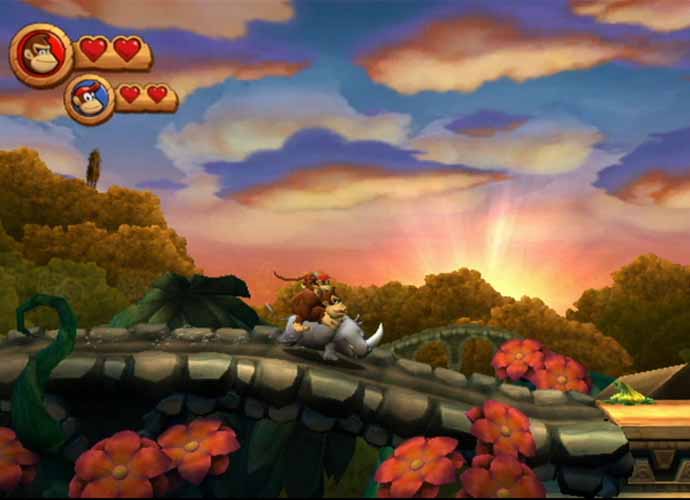‘Donkey Kong Country Returns’ Game Review

Donkey Kong Country Returns (Nintendo)
Donkey Kong Country Returns is certainly a more accurate name than simply Donkey Kong Returns, for this new Wii game installment brings back much of the flavor of the original Super Nintendo classic. Donkey Kong Country, developed by Rare, was arguably the first 2.5D side-scrolling platform game and showed that the SNES was still a viable console back in the mid-’90s when newer gaming systems like the Sony Playstation and the ill-fated Sega Saturn started to give 3D gaming more mainstream viability. Flash forward to 2010, Rare is now a subsidiary of Microsoft and a shadow it’s former self. The Texas-based Retro Studios, hot off the heels of the incredible Metroid Prime Trilogy, has provided us with Donkey Kong Country Returns the first legitimate DK platformer in over 10 years. The most impressive thing about DKCR is that it manages to be inventive even with its familiar gameplay mechanics. DKCR succeeds on the basis of its old-school thrills and inventive level design.
Donkey and Ditty Kong are once again out to recover their stolen bananas, this is of course the profound eternal crisis of our primate heroes. The lizard-based Kremlings are gone, this time the banana stash thieves are the Tiki Tak Tribe, a group of flying voodoo statues that possess DK Island’s animals and provide the various nuisances that our heroes must encounter. In keeping with Nintendo’s platformer traditions, the story is incredibly simple and solely exists so as to provide an explanation for why
anyone would want to tackle such obstacles. The plot is mostly a rehash of the first DKC, which is appropriate considering this is a quasi-remake anyway.
The game plays very much like a retooled and re-imagined version of DKC. General staples return including bananas, balloon extra lives, mine cart levels, and secret areas. Every level has 4 letters to collect which spell out KONG. Collect 100 bananas and receive another balloon. Balloons are generally easy to acquire. Donkey Kong has 2 hearts in his life meter alone and 4 when he is paired with Ditty. This time you can no longer switch between Donkey and Ditty in single player, instead Ditty provides a rocket on his back, which allows for more stable landing when jumping from platform to platform. There are other collectables as well, such as puzzle pieces that provide a secret world once all are collected.
Blast Barrels return and are more fun than ever. The level design itself is among the strongest and most innovative ever seen in a side-scrolling platformer. There’s a beach world, a jungle world, a temple world, an industrial world, and a volcano world to name a few. Without giving too much away, these themes frequently play into the levels themselves. Often there are things going on in the background which play into the foreground and provide obstacles. This makes the world Donkey Kong inhabits a more immersive one. Donkey Kong Country Returns is incredibly challenging, especially later in the game. Obstacles become very frustrating and nerve racking. This is hardly a criticism since any platformer that isn’t challenging isn’t doing its job.
As mentioned before, the worlds themselves are diverse and therefore the visuals are quite varied. There are least two levels that are silhouetted, which are very evocative of the recent Limbo for Xbox Live Arcade. Sound effects are appropriately simple. The music itself is nothing special, it’s basically the same as it was 15 years ago.
The controls themselves are the game’s biggest issue. With both Metroid Prime 3: Corruption and now Donkey Kong Country Returns, Retro Studios seems to understand the Wii Remote’s limitations and are usually able to work around it. Motion control in this game is restricted to Donkey Kong’s individual actions. Shake the Wii Remote and Nunchuk like a pair of drumsticks and Donkey Kong will slam the ground, do that while moving left or right and he’ll do a barrel roll, do it while crouching and he’ll blow wind. Surprisingly these actions rarely hinder the experience. A bigger problem is the way Donkey Kong handles, he is often klutzy while landing on platforms. It’s also difficult at times to gauge how big a jump is going to be based on how the A button is pressed. The most aggravating parts of the game are the rocket barrel levels where Donkey Kong must ride a propulsion barrel while avoiding obstructions. The problem of how hard to press the A button in order to maneuver is tenfold that of the jump function.
Donkey Kong Country Returns lives up to its name. All of what was there before has been polished over and made slicker, while being simultaneously more inventive. While it’s granted that these controls have a learning curve they’re not quite as tight as they should be. The visuals are vibrant and varied. The sound is the same as it’s always been. DKCR’s greatest achievement is that it manages to be inventive while working within gameplay mechanics that are over 15 years old.





